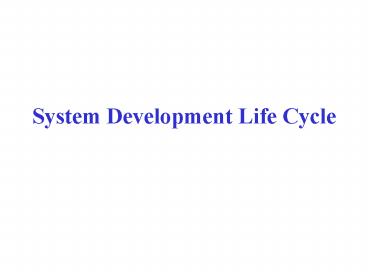System Development Life Cycle - PowerPoint PPT Presentation
Title:
System Development Life Cycle
Description:
System Development Life Cycle What is SDLC? TQM/RE TQM/RE Goals Why systems fail? Why systems fail? (Not following steps of SDLC) Six Phases of SDLC 1. – PowerPoint PPT presentation
Number of Views:49
Avg rating:3.0/5.0
Title: System Development Life Cycle
1
System Development Life Cycle
2
What is SDLC?
The formal process by which organizations build
systems is known as SDLC. Also referred to as
Application Development Life Cycle or Structured
Development Life Cycle
3
TQM/RE
TQM-Total Quality Management Set of business
practices which improve profit and
productivity RE- Reengineering/Process
Innovation Changing fundamental
procedures reexamining/repositioning
corporate Strategies.
4
TQM/RE Goals
- Improve quality of all company activities
- Reduce costs
- Improve timelines
- Other business goals
5
Why systems fail?
- Lack of communication between people
- Continuing the old system
- Failure of parts of system not fitting
- Lack of management Support
- Technological Incompetence
- Changes in technology in the middle
- Lack of user involvement/training/support
- (missing JAD-Joint Application Development)
6
Why systems fail?(Not following steps of SDLC)
- System does not meet users needs
- Unnecessary/insufficient hardware is acquired
- Software inadequately tested
7
Six Phases of SDLC
- Preliminary Investigation
- Systems Analysis
- Systems Design
- Systems Development/Acquision
- Systems Implementation
- Systems Maintenance
- Person in charge Project LeaderSystem
Analyst/Engineer
8
1. Preliminary Investigation (feasibility study)
Determine the organizations objective Read
internal/external documents Interview
users/executives Nature and scope of
problems Propose alternative solutions leave the
system as is modify the existing
system develop a new system Describe
costs/benefits of each solution Submit a
preliminary plan with recommendation
9
1. Preliminary Investigation
Benefits Tangible Cost savings Profitability/Prod
uctivity Intangible Employer satisfaction
BPR (Business Process reengineering) independent
of IT Processes are identified for
bottlenecks, removed, then IT is applied.
10
2. System Analysis
Gather data documents, interviews,
questionnaires, observations, sampling Analyze
data CASE tools, DFDs, Data Dictionary, System
Flowcharts, Connectivity Diagrams, Grid Charts,
Decision Tables Write a report Written
report Approval from the Manager next phase
11
3. System Design
Preliminary Design describes the functional
capabilities of the system CASE tools, PM
Software Detailed Design Output
Requirements Input Requirements Storage
Requirements Processing/Network
Requirements System Backup
12
4. System Development
Substantial expenditures of money/time Acquire
software Acquire hardware Test the System Unit
Testing Integrated testing Workable system
ready to be implemented
13
5. System Implementation
ObjectiveTo make system not just workable but
successful 1. Software Conversion/Data
conversion 4 Major strategies Direct
Implementation Parallel Implementation Phased
Implementation Pilot Implementation 2.
Documentation 3. Training
14
4. System Maintenance
Never ending phase Adjustments/improvements syst
em monitoring Auditing- independent auditors
review Evaluation- outside system analyst Once
the system is old enough SDLC is started all
over again.































